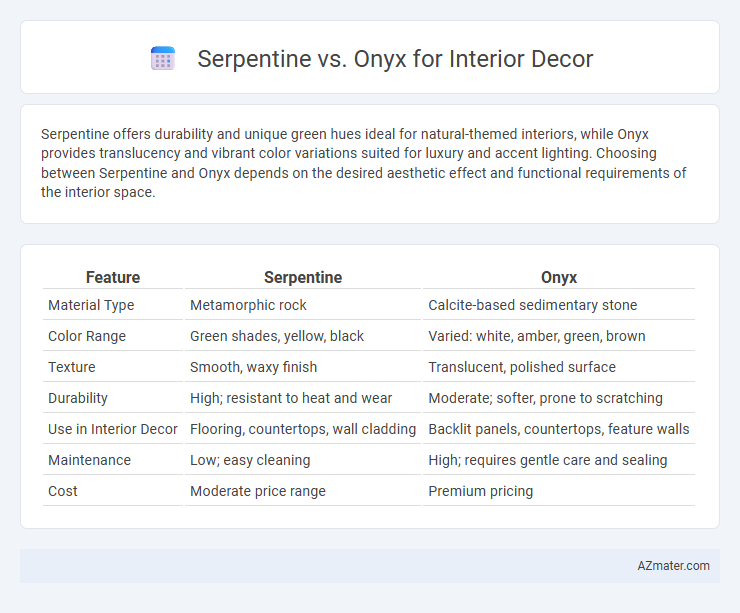Serpentine offers durability and unique green hues ideal for natural-themed interiors, while Onyx provides translucency and vibrant color variations suited for luxury and accent lighting. Choosing between Serpentine and Onyx depends on the desired aesthetic effect and functional requirements of the interior space.
Table of Comparison
| Feature | Serpentine | Onyx |
|---|---|---|
| Material Type | Metamorphic rock | Calcite-based sedimentary stone |
| Color Range | Green shades, yellow, black | Varied: white, amber, green, brown |
| Texture | Smooth, waxy finish | Translucent, polished surface |
| Durability | High; resistant to heat and wear | Moderate; softer, prone to scratching |
| Use in Interior Decor | Flooring, countertops, wall cladding | Backlit panels, countertops, feature walls |
| Maintenance | Low; easy cleaning | High; requires gentle care and sealing |
| Cost | Moderate price range | Premium pricing |
Introduction to Serpentine and Onyx
Serpentine, a group of green-hued minerals, is prized in interior decor for its unique, mottled patterns and versatility in applications such as countertops and wall cladding. Onyx, a banded calcite stone with translucent properties and striking layers of white, orange, and green, offers a luxurious aesthetic often used in feature walls and backlit installations. Both stones provide distinct textural and color variations that enhance the ambiance and sophistication of interior spaces.
Geological Origins and Composition
Serpentine, formed from the alteration of ultramafic rocks in subduction zones, is rich in magnesium silicate minerals and often exhibits a greenish hue with a smooth, waxy texture. Onyx is a variety of banded chalcedony composed primarily of silicon dioxide, created through the deposition of silica in caves or hydrothermal environments, resulting in striking parallel layers of white and colored bands. The distinct geological origins and mineral compositions of serpentine and onyx influence their durability, appearance, and suitability in interior decor applications.
Aesthetic Differences: Color and Pattern
Serpentine features rich green hues with swirling patterns that evoke a natural, earthy ambiance, ideal for creating dynamic focal points in interior decor. Onyx, characterized by its translucent layers and warm tones ranging from creamy white to deep amber, offers a luxurious and luminous aesthetic that enhances light reflection. The distinct color and pattern differences between serpentine and onyx make them uniquely suited for contrasting design styles, from rustic to modern elegance.
Durability and Longevity in Interior Use
Serpentine offers moderate durability with a Mohs hardness of 3 to 6, making it suitable for low-traffic interior surfaces but prone to scratches and etching over time. Onyx, while visually striking due to its translucency and rich colors, is softer and more fragile, with a Mohs hardness of 3 to 4, requiring careful maintenance to prevent damage. For long-lasting interior decor, serpentine provides better resilience against wear, whereas onyx is best reserved for decorative applications where durability is less critical.
Light Transmission and Visual Impact
Serpentine offers a translucent quality that allows light to softly diffuse through its green and yellow hues, creating a warm and inviting ambiance ideal for backlit panels and feature walls. Onyx, renowned for its high translucency and dramatic veining, provides a striking visual impact when illuminated, enhancing luxury interiors with bold contrasts and vibrant color variations. Both stones transform spaces by leveraging light transmission, but Serpentine delivers a subtle, organic glow while Onyx commands attention with intense luminosity and intricate patterns.
Maintenance and Cleaning Requirements
Serpentine requires gentle cleaning with mild soap and water to avoid damage to its relatively softer surface, while Onyx demands more cautious maintenance due to its porous and delicate nature, often sealed to prevent staining. Onyx should be cleaned with a pH-neutral cleaner to preserve its translucency and avoid etching, whereas Serpentine's durability allows for slightly more robust cleaning methods. Regular sealing of Onyx and periodic polishing of Serpentine are essential to maintain their aesthetic appeal in interior decor.
Cost Comparison and Value
Serpentine offers an affordable option for interior decor with prices significantly lower than Onyx, often ranging between $20 to $50 per square foot compared to Onyx's $75 to $200 per square foot. While Onyx presents a higher initial cost, its translucent properties and luxurious aesthetic contribute to greater long-term value in upscale designs and light-enhanced applications. Budget-conscious projects benefit from Serpentine's durability and unique green hues, whereas premium interiors leverage Onyx's exclusivity and striking visual impact to justify the investment.
Popular Applications in Interior Decor
Serpentine is favored for interior decor due to its rich green hues and smooth texture, often used in countertops, wall tiles, and decorative accents that add a natural, luxurious feel to spaces. Onyx, prized for its translucency and striking veining, is commonly applied in backlit feature walls, countertops, and bespoke furniture pieces to create dramatic lighting effects and sophisticated aesthetics. Both stones enhance interior design with unique color palettes and textures, but serpentine's durability suits high-traffic areas while onyx's fragile nature requires careful placement in low-impact zones.
Sustainability and Environmental Considerations
Serpentine and Onyx differ significantly in sustainability and environmental impact for interior decor; Serpentine is a more eco-friendly choice due to its abundance and lower extraction footprint, while Onyx, being rarer and often imported, has a higher carbon footprint. Serpentine's durability and resistance reduce the need for frequent replacement, promoting long-term sustainability in interior applications. Onyx, despite its luxurious appearance, requires careful consideration regarding quarrying methods and transportation emissions to minimize environmental harm.
Choosing Between Serpentine and Onyx for Your Space
Serpentine offers a rich green palette with unique veining, ideal for creating a calming and natural ambiance in interior decor, while onyx showcases translucent qualities and dramatic banding that enhance elegance and luxury. Choosing between serpentine and onyx depends on whether the space benefits more from a vibrant, earthy tone or a sophisticated, luminous effect. Consider durability, maintenance, and light exposure in your space to maximize the aesthetic impact and longevity of the selected stone.

Infographic: Serpentine vs Onyx for Interior Decor
 azmater.com
azmater.com